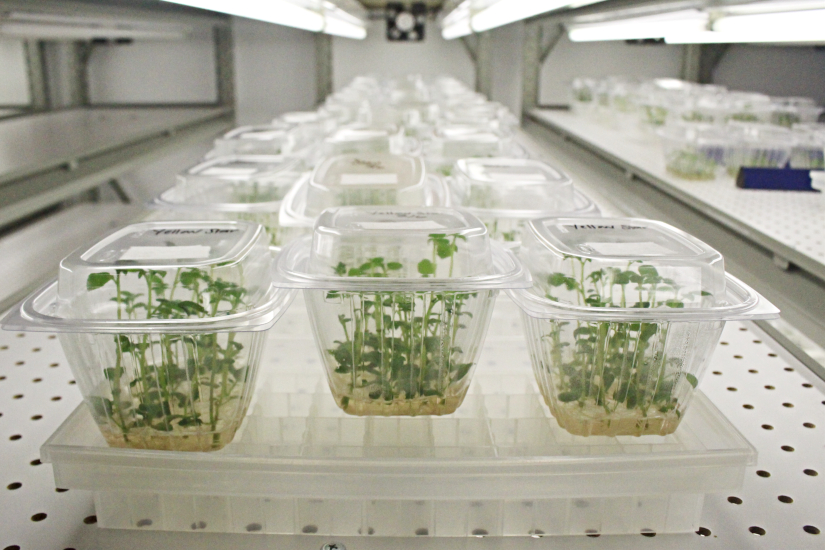
Hybrid potato breeding offers huge potential
Potatoes can be a tough crop to grow. Seed tubers are bulky, perishable and quickly degenerate when pressured by disease. Furthermore, improvement of existing varieties has been slow.
Traditional breeding is almost impossible, which leaves selection as the only option for potato breeders. This explains why Russet Burbank, first created in 1902, is still the most popular variety grown in the United States today.
Selective breeding is most challenged by abrupt change, as breeders are unable to respond quickly. Hein Kruyt, CEO of Solynta, believes hybrid breeding could change that. He explained the advantages of hybrid breeding in a webinar at for the World Potato Congress.
In a quick lesson on genetics Kruyt outlined the challenges faced by potato breeders. Typically, he said, potatoes are grown from seed tubers that were harvested and saved from the previous year’s harvest. Once the plant starts growing the next year it will begin to flower.
“If the flowers are inseminated, then small fruit start to develop into a berry filled with potato seeds,” said Kruyt. “These seeds are called true potato seeds, as to distinguish them from the seed tuber.”
Growers, researchers and breeders have tried to use the true potato seeds as starting material. Potatoes, Kruyt reminded participants, have almost 40,000 genes. Crossing them results in completely random, heterogeneous true potato seeds. Plants grown from true potato seeds will develop completely different from one plant to the next. Some will mature early, while others will mature late. Some will bear tubers, and others will not.
Hybrid breeding could remove that randomness, said Kruyt. Solynta breeding technology works by sexual propagation, he explained, crossing elite lines of male and female “parent” potatoes to produce new hybrid offspring that share the best features of both parents. Based in The Netherlands, Solynta is the inventor of hybrid potato breeding.
What makes the process interesting to many is that it is completely natural. A bee could have done it, said Kruyt, if only that bee had known which plants he had to visit.
The benefits of hybrid breeding are many. Starting material in traditional production is taken from already developed tubers. Each tuber produces about 10 tubers. Those tubers need to be stored in acclimatized conditions in order to be used the following year for planting.
Using the hybrid breeding system, however, each plant can make about 5,000 seeds per female plant. Those 5,000 seeds can create a further 25 million seeds in a year. If all of those seeds are sown, they can produce up to 250 million first generation tubers.
Basically, it’s like a copying machine that can quickly produce clean seed, said Kruyt.
What’s even more interesting is how much weight is reduced. One hectare of hybrid true potato seeds weighs just 25 grams versus 2,500 kilos of seed tubers.
“It takes limited imagination to see the logistical benefits in shipping grams in an envelope versus tons of perishable tubers in acclimatized containers,” he said. “Seeds stay healthy for years without any special storage conditions versus perishable tubers which go bad quite quickly if not stored properly.”
RELATED: Are diploid potatoes in your future?
On top of the logistical benefits, hybrid true potato seeds offer benefits from the phyto-sanitary point of view. Seed tubers can carry pathogens, as well as infected soil, which is why the import and export of tubers is strictly regulated. But hybrid true potato seeds are produced in a controlled environment where the parent stock is free of disease. The resulting offspring is also free from disease.
“This means hybrid true potato seeds could move across the world easily, like any other vegetable seeds with full phyto-sanitary control,” said Kruyt.
But what’s more is that for the first-time potato breeding has become targetable, predictable, fast and efficient, said Kruyt. Solynta believes hybrid breeding can unlock hybrid vigor for the first time.
“We foresee a yield increase of 30% in the developed world,” he said. “And a doubling of the yield in the developing world within the next 10 years.”
Another benefit of the hybrid system is that it is quite easy to enrich an existing hybrid with specific traits while keeping all the other elements of that variety intact. Improvements with additional traits can be made in as little as three years. Solynta was able to demonstrate their ability to do this by developing a variety with resistance to late blight, and that variety was developed with two resistant genes in only two years.
“This stacking of beneficial genes is probably one of the most important aspects of hybrid breeding,” said Kruyt. “It enables us the ability to improve varieties with beneficial traits almost at infinitum.”
Breeders could create more robust varieties for harsh climates where excess heat and drought are possible. Breeders could create varieties with salinity tolerance. With consumers in mind, they would be able to improve taste and aesthetics, including shape, color, size and skin texture. They could even improve traits for processing, such as protein or starch content. They could reduce waste by optimizing shape, storability, dormancy and bruising. The possibilities are endless.
Earlier this year, Solynta was granted U.S. Patent Serial No. 10,524,436 entitled “Hybrid Potato Breeding. The patent claims Solynta’s methods of producing potato inbreds and hybrids that are propagated from true seed.
— Global Perspectives takes a look at international developments in the potato industry and how they may affect the U.S. industry. More can be found here.







